Just looking for our Best Winery Website examples list?
Why Winery Website Design Matters More Than Ever
A well-crafted website is no longer a luxury—it’s your most powerful sales and branding tool. Whether your vineyard is nestled in Napa or serving small-batch bottles across the Midwest, your presence online needs to tell a compelling story, drive conversions, and reflect the premium quality of your product.
Today’s wine consumers are tech-savvy, research-driven, and expect a seamless user experience from browsing to buying. That means your site design must go beyond aesthetics. It must offer an intuitive theme, highlight your monthly bottle club, optimize for SEO, and guide users from the homepage to the tasting offerings, and straight through to your e-commerce product pages.
In this comprehensive winery website design guide, we’ll break down everything you need to create a high-quality digital experience that engages visitors and delivers business results. Whether you’re launching a new site or rethinking your current layout, you’ll learn how to blend storytelling, functionality, and strategy to attract more customers and sell more wine online.
Website Planning & Purpose: Building the Foundation for Success
Before a single pixel is designed, a successful website begins with strategy. The planning phase isn’t just about selecting fonts or colors—it’s about defining the goals your website needs to achieve and aligning those with the expectations of your audience. For wineries, this typically includes promoting your brand’s story, increasing direct-to-consumer sales, encouraging club sign-ups, and boosting foot traffic to your tasting space.
Start by identifying your target customer. Are you catering to weekend tourists looking for a vineyard experience? Wine club members expecting exclusive offers? Or distributors and retailers seeking background on your wine portfolio? Each audience segment requires unique messaging and functionality—from intuitive navigation for online shoppers to immersive storytelling for first-time visitors.
Next, map out your content needs. Wineries often juggle multiple business functions—hospitality, ecommerce, events, and wine education. Your site must account for product pages that showcase your wine, clear calls to action for joining the monthly club, and optimized landing pages for SEO that help users find your brand in local and national searches.
Don’t forget performance. A website must load quickly, be mobile responsive, and provide a smooth user experience across all devices. Planning for technical infrastructure early helps avoid headaches later.
If you’re new to this phase or need to rethink your approach, check out our breakdown of the core principles of web design, which outlines how clarity, function, and purpose drive every successful digital project. These fundamentals are critical to ensuring your website delivers measurable impact and lasting brand value.
Design Principles for a High-Performing Website
Effective site design is rooted in a few timeless principles that ensure both form and function work together to elevate your brand and grow your business. Great design doesn’t just look beautiful—it guides visitors, builds trust, and drives action.
First, prioritize clarity and simplicity. Visitors should instantly understand who you are, what you offer, and how to engage. Use clean layouts, generous white space, and visual hierarchy to highlight key areas like your tasting room, wine membership club, or online store. Avoid clutter and keep messaging concise to avoid overwhelming users.
Second, design with user experience in mind. That means intuitive navigation, especially for mobile users, fast-loading pages, and accessible design for all visitors. A user-friendly experience keeps customers engaged and encourages them to explore your vineyard’s story and wine offerings more deeply.
Third, leverage consistent branding. Your color palette, typography, photography, and tone should all reflect the unique personality of your winery. Whether you’re a rustic boutique vineyard or a sleek, modern label, your website should reflect that identity through every design choice.
Fourth, optimize for engagement. Use high-quality visuals—bottle shots, vineyard landscapes, and lifestyle imagery—to draw users in. Incorporate calls to action that invite exploration: “Book a Tasting,” “Join Our Club,” or “Shop Our Wines.” These actions should feel natural and strategically placed to support conversions.
For a full walkthrough of how these principles come to life during the design process, explore our step-by-step guide to the web design process. Understanding how each decision connects back to your goals is the key to building a website that performs as beautifully as it looks.
Content & Navigation: Structuring the Website Experience
Content and navigation are the backbone of any successful website. A beautifully designed site means little if users can’t find what they need—or if your message fails to connect. A well-organized content structure is essential to guide different types of visitors: wine lovers looking to shop, travelers seeking tasting details, and loyal fans interested in your monthly club selections.
Start with a clear sitemap. Your main menu should include Home, Our Wines, Visit Us, Wine Club, About, and Contact. If you host events or offer virtual tastings, include dedicated pages to make them easy to find. Keep the top menu concise—no more than six to seven items—and use dropdowns sparingly to avoid overwhelming users.
Each page should have a defined goal. For example, your wine products should include tasting notes and pricing, compelling photography, awards, and clear options to purchase or learn more. The Visit Us page should showcase the tasting experience with high-quality imagery, maps, and reservation links. The Club page must clearly explain benefits, tiers, and how to join.
Content needs to balance storytelling with action. Use your About page to highlight your heritage, mission, and business best practices. Weave in your brand values throughout the site, reinforcing trust and connection. For every story, guide visitors toward the next step—whether that’s making a reservation or subscribing to your email list.
To organize everything effectively, follow the structure outlined in our website organization guide. It breaks down how to plan and build content that aligns with your goals, supports user flow, and ultimately turns visits into conversions. For wineries, strategic layouts and purposeful content turn casual browsers into loyal customers.
Visual Elements That Bring Websites to Life
In the wine industry, visual storytelling isn’t optional—it’s expected. A website must evoke emotion, convey quality, and immerse visitors in the overall experience. Visual elements play a central role in shaping user perception, guiding users, and strengthening your brand identity.
Start with photography. High-resolution images of your location, tastings, wine bottles, and behind-the-scenes moments build authenticity and trust. These visuals should reflect your brand’s tone, whether rustic and charming or sleek and modern. Professional photography is a smart investment, as it enhances every corner of your site from homepage hero sections to wine products.
Video can elevate your digital presence even further. Background videos of the setting at sunrise, footage from harvest season, or interviews with the winemaker help tell a rich story that static images can’t fully capture. These elements increase engagement and convey your values and attention to craft.
Design consistency is key. Your use of color, typography, iconography, and spacing should align with your wine label and packaging. This unified presentation reinforces brand recognition and creates a seamless offline-to-online experience. Fonts should be easy to read, and colors should offer high contrast to maintain accessibility while still feeling elegant.
Every visual element should have a purpose. Use infographics to explain club benefits or illustrate your wine-making process. Embed maps with custom styling for your room for tastings. Even subtle details—like hover effects, animation speed, or button shape—impact how polished and trustworthy your winery appears.
Ultimately, visual design should make your site beautiful and usable. It should guide visitors naturally from discovery to action, encouraging them to browse, taste, and buy with confidence. A visually rich and cohesive website is one of the most effective ways to convey value, stand out from competitors, and drive real-world results.
Ongoing WordPress Maintenance for Websites
A website is not a set-it-and-forget-it investment—especially if it’s built on WordPress. While WordPress offers the flexibility and performance needed to run a high-end, content-rich website, it also requires ongoing maintenance to stay secure, functional, and optimized for users and search engines.
First and foremost, software updates must be managed regularly. This includes the WordPress core, theme files, and all plugins. Ignoring updates can lead to broken functionality, vulnerabilities, or compatibility issues that affect the user experience and expose your site to security threats.
Security should be a top priority, particularly for wineries running ecommerce features like wine sales, subscriptions, and event ticketing. Implement firewalls, malware scanning, and SSL certificates, and monitor for suspicious activity. Regular off-site backups are essential so your site can be restored quickly if anything goes wrong.
Performance optimization is another key area. A slow website can reduce conversions and hurt your SEO. Winery sites are often image-heavy, so it’s crucial to compress images, enable caching, and use a content delivery network (CDN) to keep load times fast across all devices.
Routine content and functionality audits help identify broken links, outdated information, or new opportunities to engage users. This is especially important for seasonal updates like new wine releases, upcoming events, or tasting room hours. Keeping your content fresh shows visitors that your brand is active, engaged, and professional.
Just like maintaining your vineyard, your website needs consistent care to perform at its best. Ongoing maintenance protects your investment and ensures that every visitor has a seamless experience, whether they’re joining your monthly club, booking a tasting, or placing an online order.
Best Winery Website Design Examples
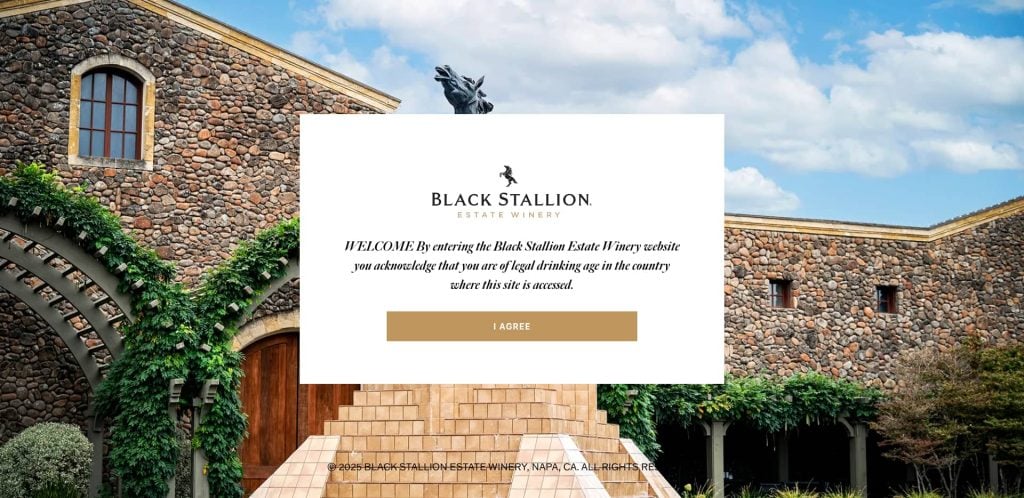
1. Black Stallion Estate Napa
Location: Napa, California
Key Takeaways:
- Customizable event calendar for tastings and tours
- Full-width vineyard imagery anchors brand identity
- Prominent “Join Wine Club” CTA on every page
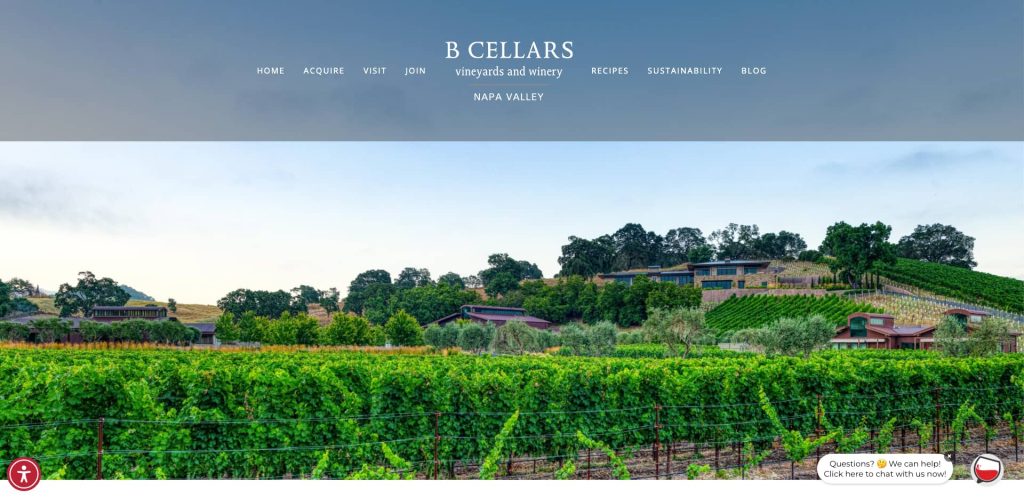
2. B Cellars
Location: Sonoma, California
Key Takeaways:
- Simplified shopping cart integrated with homepage banners
- Interactive vineyard map with tasting room details
- Clean design emphasizes tasting notes and awards
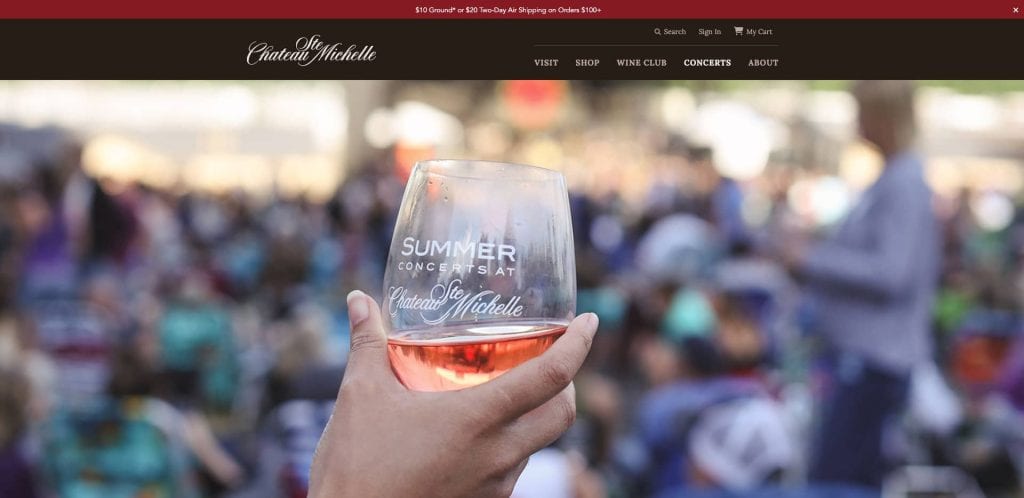
3. Chateau Ste. Michelle
Location: Woodinville, Washington
Key Takeaways:
- Scenic vineyard and barrel room visuals create immersion
- Strategically placed CTAs for tours, wine club, and events
- Airy layout reflects spacious estate ambiance
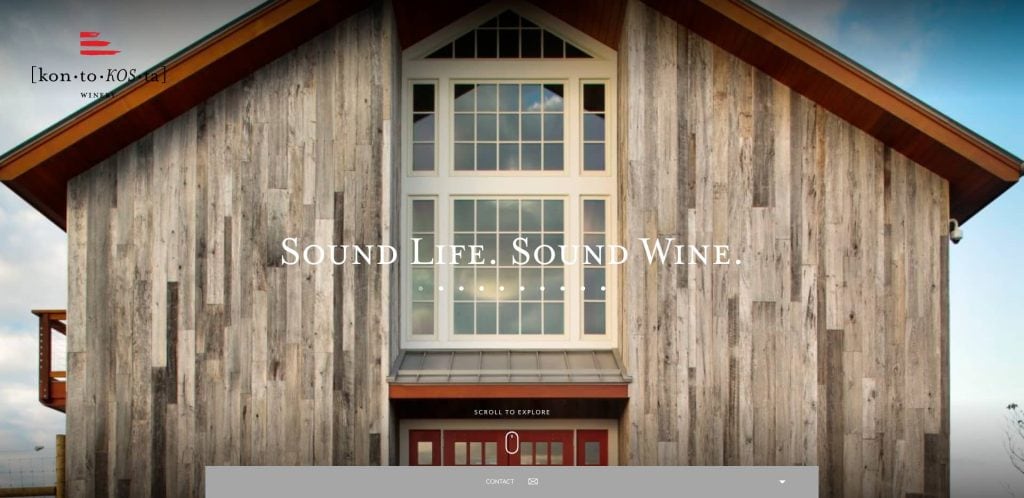
4. Kontokosta Winery
Location: Glen Cove, New York
Key Takeaways:
- Waterfront imagery evokes unique marine terroir
- Award highlight section adds credibility
- Clear tasting room access and reservation form above the fold
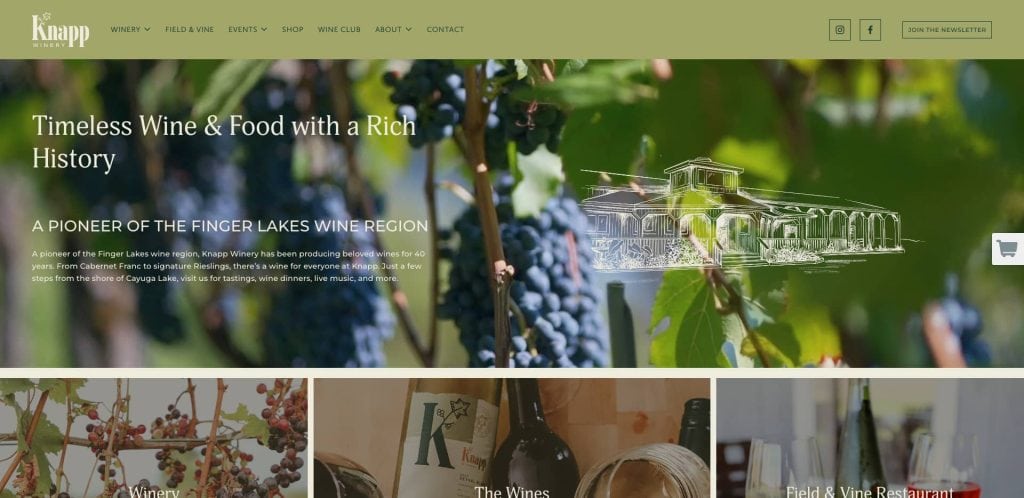
5. Knapp Winery
Location: Interlaken, New York
Key Takeaways:
- Homepage storytelling focused on history and legacy
- Live music and events schedule encourages visits
- Clear navigation between wine, food, and events
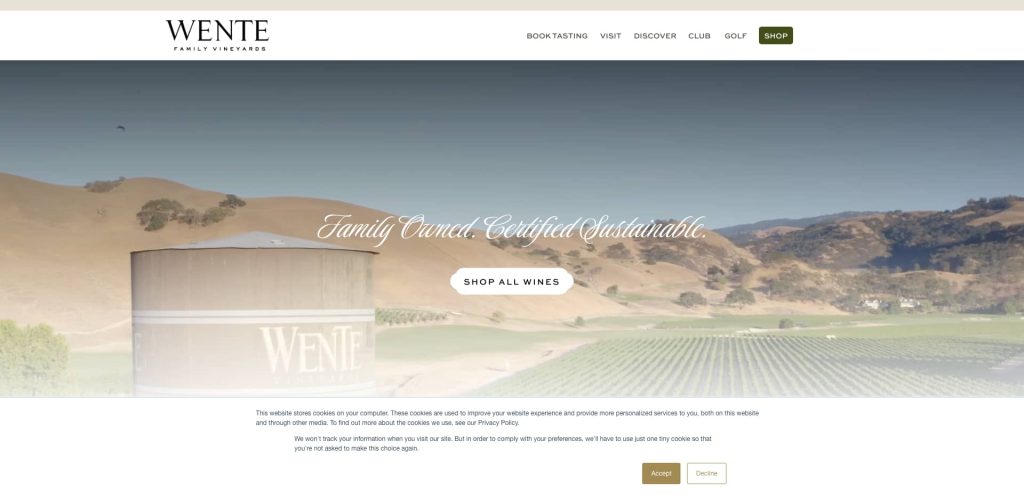
6. Wente Vineyards
Location: Livermore, California
Key Takeaways:
- Historical timeline feature enhances storytelling
- Tasting room, restaurant, and golf booking integration
- Prominent sustainability messaging
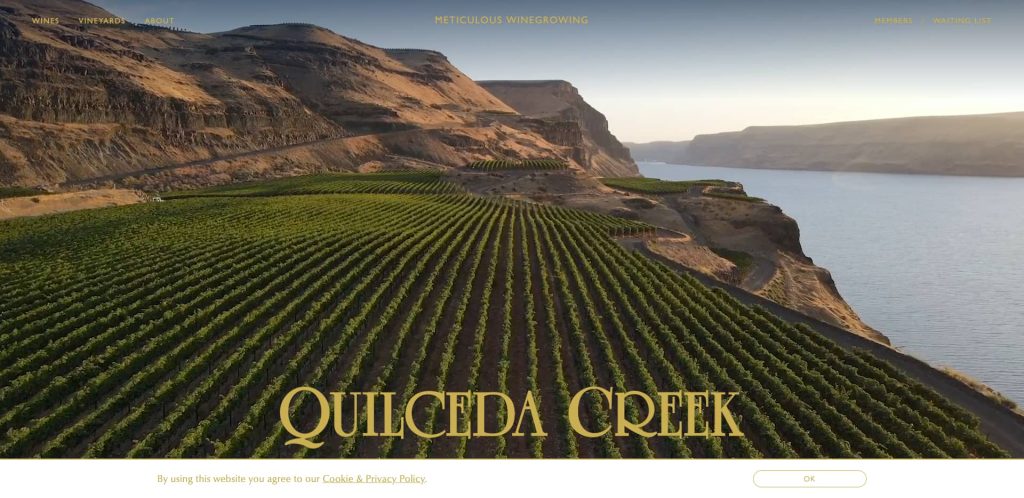
7. Quilceda Creek Winery
Location: Snohomish, Washington
Key Takeaways:
- Clean design mirrors luxury branding
- Appointment-based tasting booking simplifies UX
- Trophy case of awards builds authority
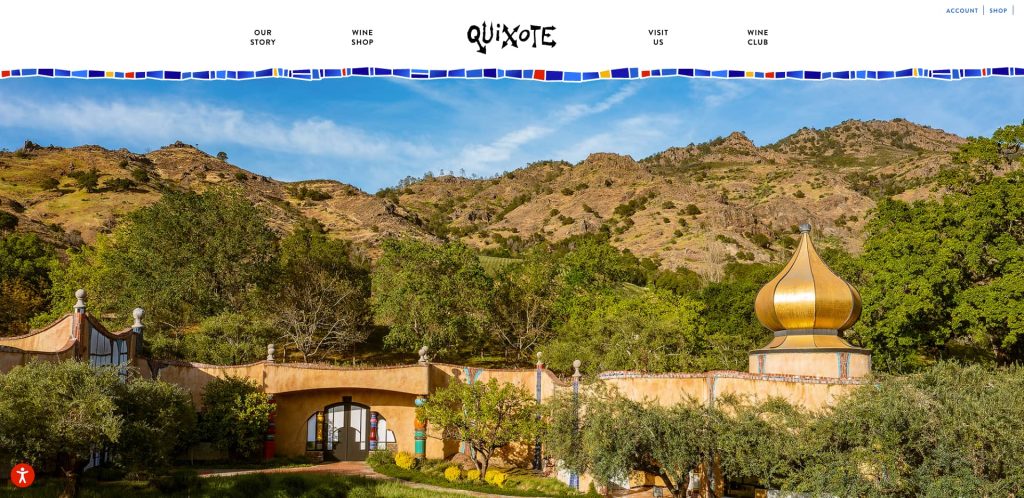
8. Quixote Winery
Location: Napa, California
Key Takeaways:
- Distinct architecture showcased through full-screen imagery
- Organic navigation flow between site and on-site tours
- Minimalist UI that highlights winemaking focus
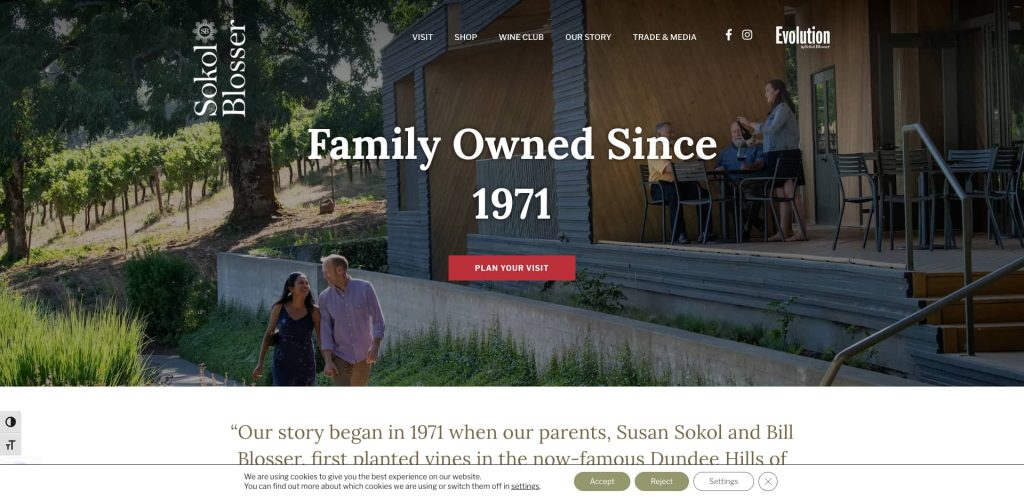
9. Sokol Blosser Winery
Location: Dayton, Oregon
Key Takeaways:
- Sustainability story prominently displayed
- LEED-certified building visual creates trust
- Intuitive page structure for wine selection and club sign-up
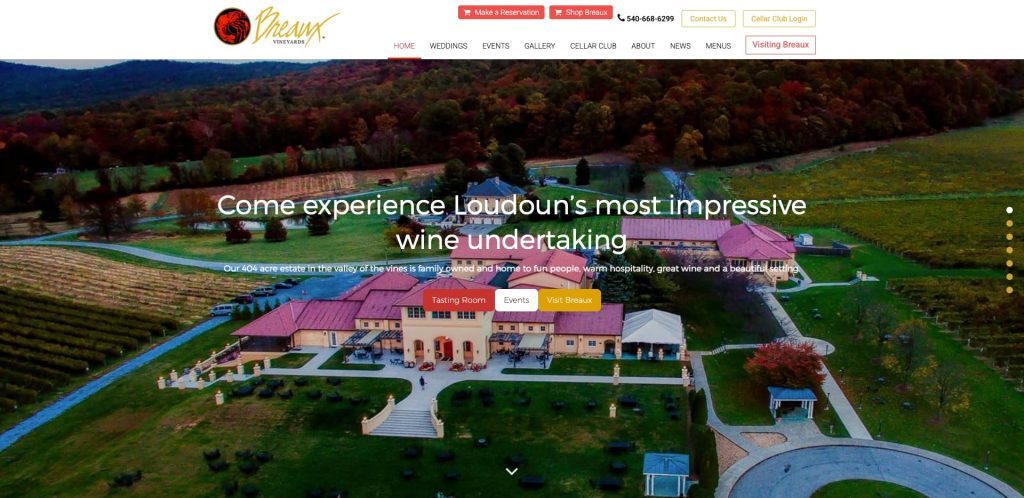
10. Breaux Vineyards
Location: Purcellville, Virginia
Key Takeaways:
- Bold Cajun branding connects with heritage
- Simple e-commerce flow for wine orders
- Clean layout ensures clear navigation for wine travel, events
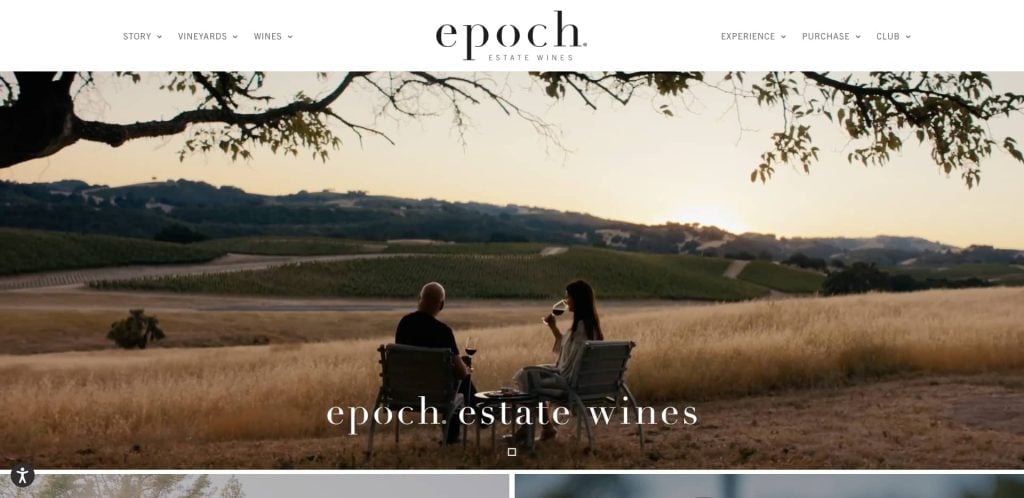
11. Epoch Estate Wines
Location: Paso Robles, California
Key Takeaways:
- Video background brings estate ambience to life
- Detailed club and tasting packages shown on one page
- Easy-to-spot CTAs to boost conversion
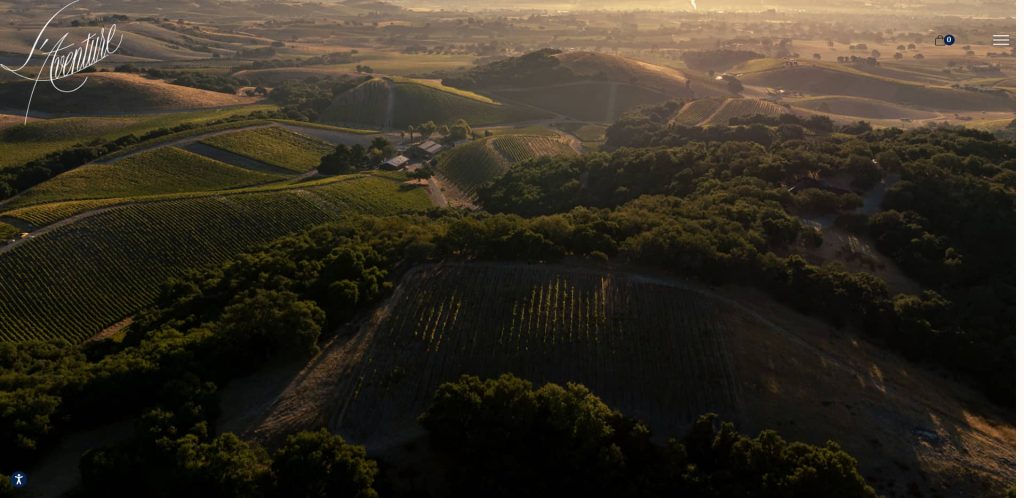
12. L’Aventure Winery
Location: Paso Robles, California
Key Takeaways:
- Organic branding reflects grape-growing philosophy
- Rich content for wine reviews and varietals
- Simple mobile-friendly inquiry form
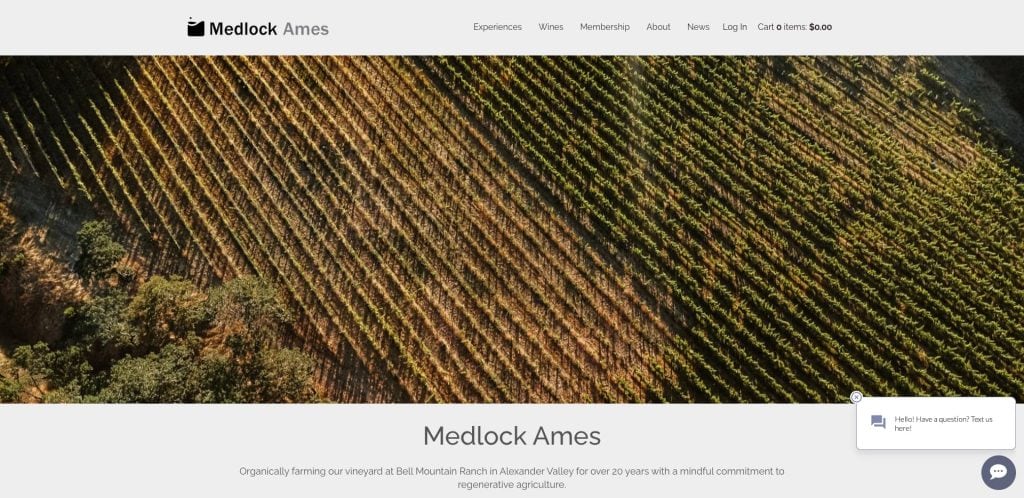
13. Medlock Ames
Location: Healdsburg, California
Key Takeaways:
- Elegant design with refined typography
- Custom floorplan map for tasting room
- Seamless wine club signup integration
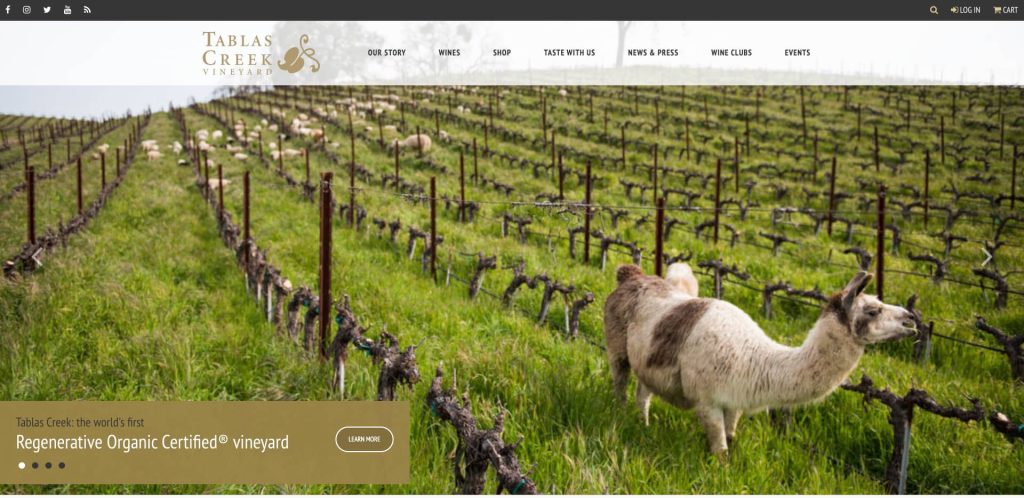
14. Tablas Creek Vineyard
Location: Paso Robles, California
Key Takeaways:
- Vineyard solar imagery reinforces sustainability
- Clear navigation to small-lot production details
- Event calendar is highly visible on homepage
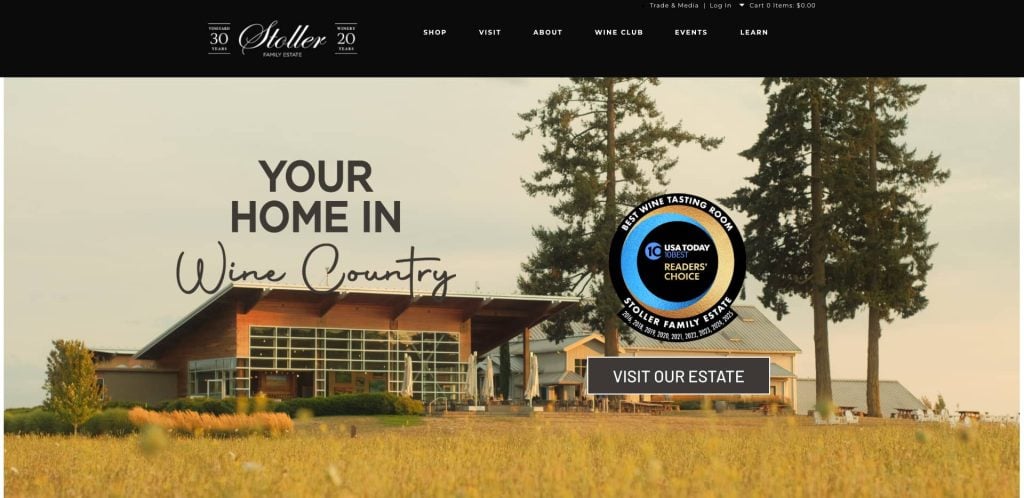
15. Stoller Family Estate
Location: Dayton, Oregon
Key Takeaways:
- Inviting design through pastoral video
- Clean e-commerce experience for dtc wine
- Prominent wine club info drives engagement
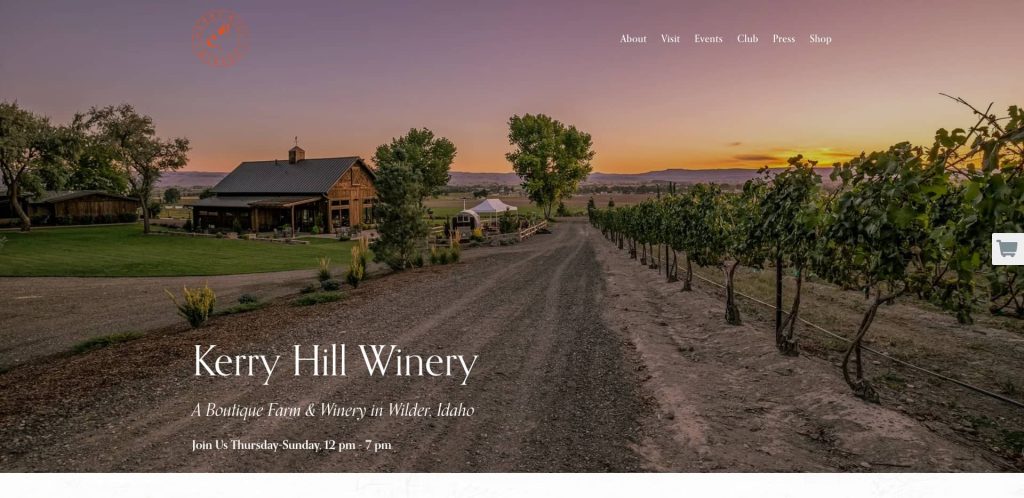
16. Kerry Hill Winery
Location: Walla Walla, Washington
Key Takeaways:
- Elegant design with high-quality images of the estate
- Responsive shopping cart for online wine purchases
- Rich storytelling in hero section
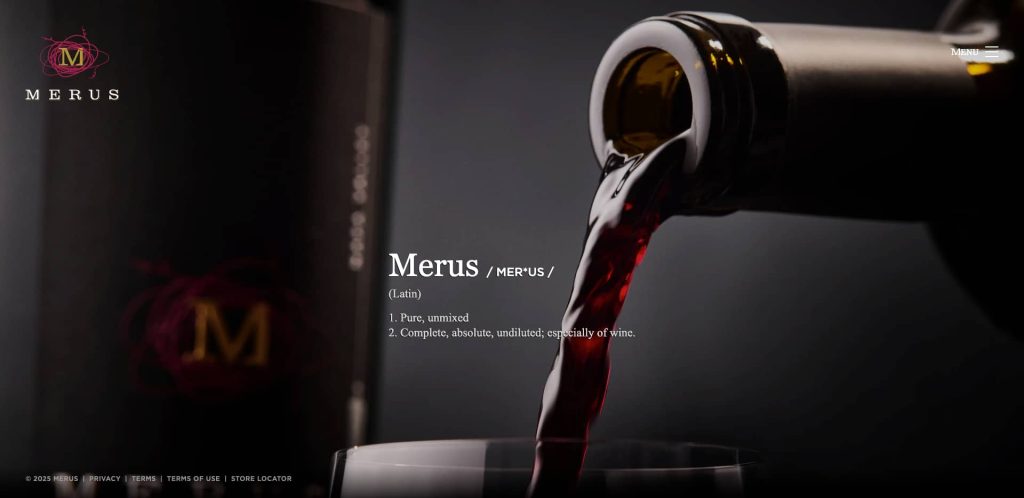
17. Merus Wines
Location: Napa, California
Key Takeaways:
- Minimalist design keeps focus on wines
- Streamlined e-commerce workflow
- Clear wine club signup and tasting room CTA
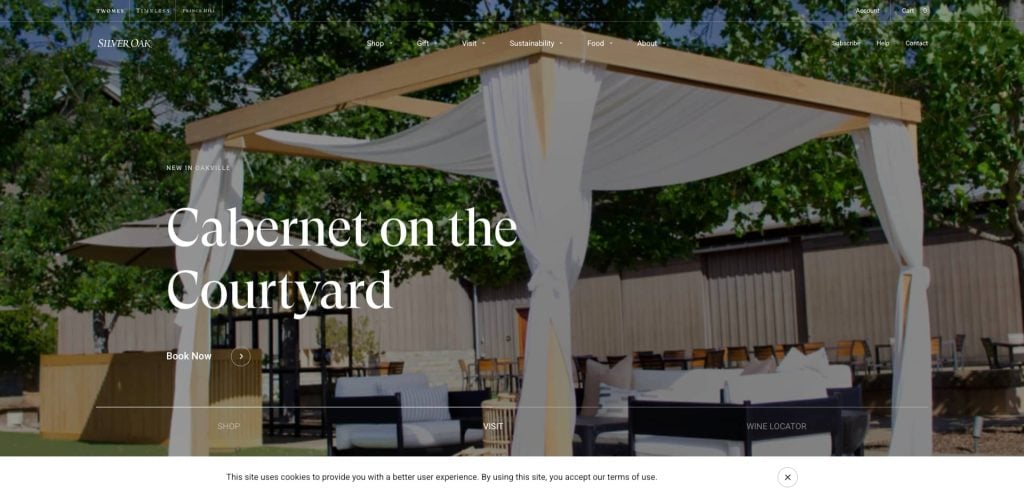
18. Silver Oak Winery
Location: Oakville, California
Key Takeaways:
- Luxurious design echoes premium brand
- Full-width imagery and straightforward navigation
- Easy access to club and events
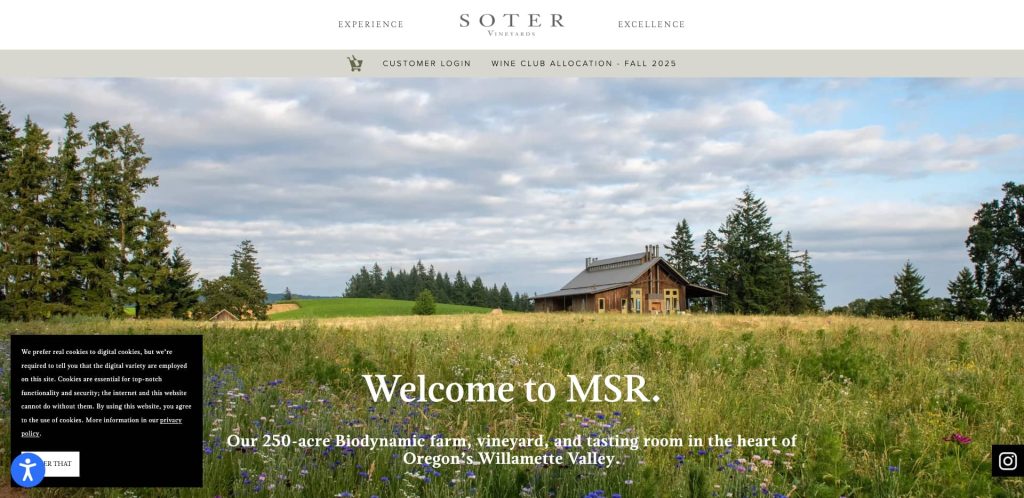
19. Soter Vineyards
Location: Carlton, Oregon
Key Takeaways:
- Clean design emphasizing minimalist aesthetic
- Effective wine club info placement above fold
- Mobile-friendly event booking integration
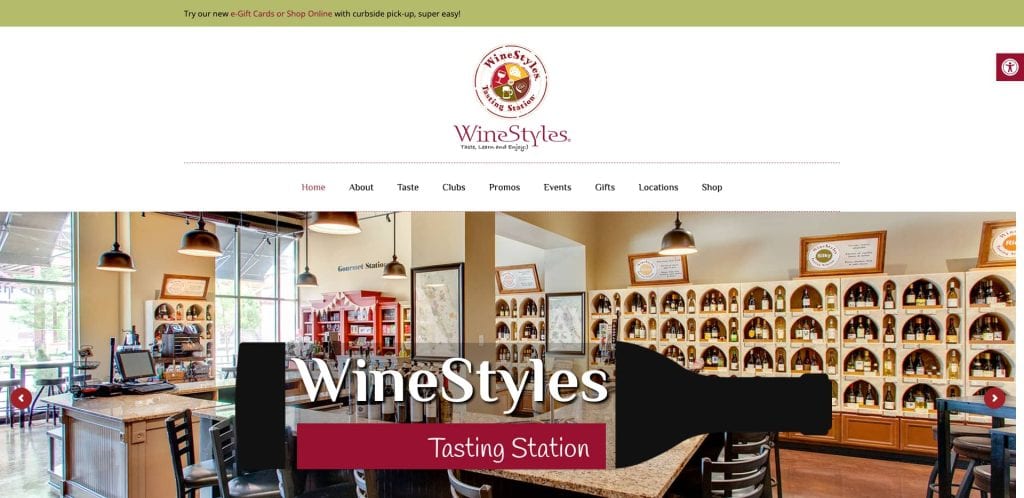
20. Wine Styles
Location: Paso Robles, California
Key Takeaways:
- Stunning imagery with intuitive shopping cart
- Elegant, inviting design with refined typography
- Wine club highlighted throughout site
Ready to Elevate Your Winery’s Website?
Your winery’s website should be more than a digital placeholder—it should be a strategic tool that boosts sales, builds brand loyalty, and connects deeply with your audience. Whether you’re showcasing wine collections, streamlining online sales with elegant e-commerce features, or improving ease of use for wine enthusiasts, the right design and content choices can transform your results. A well-designed website exudes luxury, reinforces your brand’s unique story, and makes it easy for customers to buy wine, explore your destination, or sign up for wine tastings.
If you’re unsure how to start creating a website that aligns with best practices for website performance and design, our experts are here to help. We specialize in websites for wineries that combine refined design with marketing strategy and user-friendly functionality.
Let’s bring your vision to life—schedule a winery website consultation with our professional design and development team today and start building a digital experience that works as hard as you do.
Frequently Asked Questions About Winery Website Design
What are the best practices for creating a user-friendly website for your winery?
The best practices for website visitor experience include designing for mobile-first performance, simplifying navigation, using HD images, and making sure key features like your monthly club information and tasting room hours are easy to find. A clean design paired with an intuitive layout ensures that visitors can explore your wine collections and take action without confusion. Explore our guide to web design fundamentals to structure your winery’s presence online for maximum engagement.
How do I use digital marketing to support my website?
Digital marketing helps drive traffic to your website and convert visitors into loyal customers. Strategies like SEO, content marketing, and targeted campaigns can spotlight your DTC wine offerings, promote wine tastings, and highlight seasonal wine releases. Working with a specialized marketing agency ensures your winery’s online efforts are consistent and results-driven.
What design features make for an effective website?
An effective website includes a minimalist design with elegant visual elements, a mobile-friendly layout, a fast-loading experience, and features like a shopping cart, online booking, and monthly club signup. Incorporating stunning imagery of your setting and winemaking process adds emotional appeal, while well-organized pages support conversion rates and sales.
Should I use a content management system (CMS) for my winery website?
Yes. A CMS like WordPress allows you to easily update events, add your bottle club information, and manage your product listings. It also supports SEO best practices and scalability as your winery grows. A CMS is essential for wineries looking to keep their site current without relying on a developer for every change.
How important are HD images and video for wine marketing?
Extremely important. In wine marketing, visuals play a key role in storytelling and brand positioning. Top-quality images of your bottles, location, and team enhance trust and professionalism. Background video or drone footage of your estate, like that featured on the Kerry Hill Winery or Merus Wines websites, can elevate the overall visitor experience and support a luxurious design aesthetic.
What type of site design ideas work best for boutique wineries?
Boutique wineries often benefit from an inviting design that highlights exclusivity and craftsmanship. This includes refined typography, minimalist layouts, personalized storytelling, and subtle animations. Incorporating elements of your physical environment—especially if you’re based in wine country—helps connect online visitors with the in-person experience.
How do I make my winery’s website mobile-friendly?
Start by using responsive design so the layout adjusts seamlessly to any screen size. Optimize image sizes for faster load times, and make sure buttons, menus, and your shopping cart are easy to use on smaller devices. A mobile-friendly design is essential for capturing traffic from users who are searching while traveling or visiting wine country.
What role does content marketing play in boosting a winery’s online presence?
Content marketing drives long-term traffic, educates customers, and builds brand loyalty. Sharing stories about your winemaking process, wine pairings, behind-the-scenes videos, or event recaps can increase time on site and organic search visibility. It’s one of the most effective marketing efforts to support a strong winery’s online presence and should be part of your ongoing digital strategy.
Why is it important to keep wine club information easy to find?
Your club is one of your most valuable revenue streams. Make it easy for users to find details on membership tiers, perks, and sign-up options. Clear visibility and persuasive content around club benefits will improve conversion rates and ensure you retain loyal customers. Strategic placement of CTAs on pages dedicated to your products and your homepage supports this goal.
What if creating a website for my winery feels overwhelming?
Creating a website for your winery can be confusing without the right support. That’s why working with a partner like us can help your winery stay focused on what it does best, while we handle design, development, and ongoing optimization. Our team ensures your site reflects your brand and supports your growth with features tailored to the wine industry. If you’re ready to boost your winery’s online impact, reach out today.



